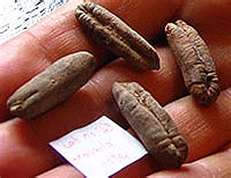The herbaceous Silene stenophylla plant, grown from fruit seeds stored more than 30,000 years ago.
The seeds, stored away by squirrels, were found in the Siberian permafrost. They were grown back to life into full flowering plants by scientists in Russia.
A map showing the location of squirrel burrows in Siberia found to contain thousands of ancient seeds.
The latest findings could be a landmark in research of ancient biological material and the bid to potentially revive other species, including some that are extinct.
The previous record for feasible regeneration of ancient plant was with 2,000-year-old date palm seeds at the Masada fortress near the Dead Sea in Israel.
The scientists emphasize the importance of permafrost itself in the “search of an ancient genetic pool, that of preexisting life, which hypothetically has long since vanished from the earth’s surface”.
The latest success is older by a significant order of magnitude, with researchers saying radiocarbon dating has confirmed the tissue to be 31,800 years old, give or take 300 years.
The permafrost essentially acted as a giant freezer, and the squirreled-away seeds and fruit resided in this closed world, undisturbed and not thawed, at an average of minus 7 degrees Celsius (19 degrees Fahrenheit) for tens of thousands of years.
All burrows were found at depths of 20-40 meters (65 to 130 feet) from the present day surface and located in layers containing bones of large mammals such as mammoth, woolly rhinoceros, bison, horse, deer, and other representatives of fauna from the Late Pleistocene Age.
Scientists were able to grow new specimens from such old plant material in large part because the burrows were quickly covered with ice, and then remained “continuously frozen and never thawed,” in effect preventing any permafrost degradation.
In their lab near Moscow, the scientists originally sought to grow plants from mature S. Stenophylla seeds, but when that failed, they turned to the plant’s placental tissue, the fruit structure to which seeds attach, to successfully grow regenerated whole plants in pots under controlled light and temperature.
Scientists have known for years that certain plant cells can last for millennia under the right conditions.
Some earlier claims of regeneration have not held up to scientific scrutiny, but the Yashina/Gilichinsky team was careful to use radiocarbon dating to ensure that the seeds and fruit found in the permafrost were not modern contaminants from S. Stenophylla, which still grows on the Siberian tundra.
